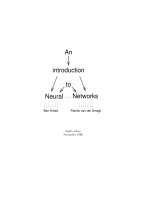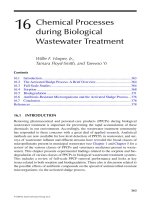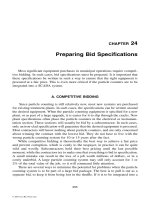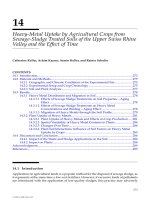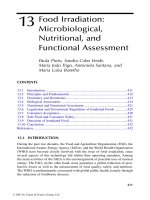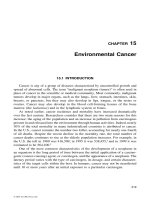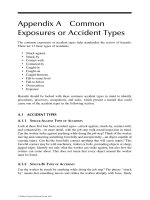STREAM ECOLOGY & SELF PURIFICATION: An Introduction - Chapter 14 (end) pptx
Bạn đang xem bản rút gọn của tài liệu. Xem và tải ngay bản đầy đủ của tài liệu tại đây (1.01 MB, 32 trang )
CHAPTER
14
Final Comprehensive Examination
J
Note:
Answers appear in Appendix
B.
14.1
A TMDL is essentially a
14.2
refers to the sum of all dissolved constituents in a water
sample.
14.3
are net spinners.
14.4
Inhabit the open water limnetic zone of standing waters:
14.5
Most food in a stream comes from
the stream.
14.6
Slow-moving streams
are
dominated
by
and
14.7
Most streams are primarily food chains.
14.8
A lotic system is
,
while a lentic system is
14.9
Name the three zones of a lotic habitat.
14.10
The major difference between land and freshwater habitat is in the
in which they both exist.
14.11
State Hardin's First Law of Ecology.
Copyright © 2001 by Technomic Publishing Company, Inc.
226
FINAL COMPREHENSIVE EXAMINATION
14.12 What is the main axiom of population ecology?
14.13 Net yield is the same as
14.14 The major ecological unit is:
(a) Biosphere
(b) Lithosphere
(c) Ecosystem
(d) Pond
14.15 Organisms residing within or on the bottom sediments are referred to as:
(a)
Benthos
(b) Periphyton
(c) Plankton
(d) Neuston
14.16 Organisms attached to plants or rocks are referred to as:
(a) Benthos
(b)
Periphyton
(c) Pelagic
(d) Neuston
14.17 Small plants and animals that move about with the current are:
(a) Plankton
(b) Periphyton
(c) Pelagic
(d) Neuston
14.18 Free-swimming organisms belong to which group of aquatic organisms:
(a) Plankton
(b) Periphyton
(c) Pelagic
(d) Neuston
14.19 Organisms that live on the surface of the water are:
(a) Benthos
(b) Periphyton
(c) Neuston
(d) Pelagic
Copyright © 2001 by Technomic Publishing Company, Inc.
Final Comprehensive Examination
14.20 Which element is essential in the construction of proteins and amino ac-
ids:
(a) Nitrogen
(b) O~Y gen
(c)
Phosphorus
(d) Potassium
14.21 The source of phosphorus is:
(a) Atmosphere
(b) Hydrosphere
(c) Lithosphere
(d) Biosphere
14.22 Rate of reproduction (or birth rate) is called:
(a) Natality
(b) Mortality
(c) Immigration
(d) Emigration
14.23 Movement of new individuals into a natural area is referred to as:
(a) Natality
(b)
Mortality
(c) Immigration
(d) Emigration
14.24 The maximum number of individuals of a particular species that a natural
area can support is:
(a) Population
(b) Community
(c) Ultimate limit
(d)
Carrying capacity
14.25 The main source of nitrogen is:
(a) Atmosphere
(b) Hydrosphere
(c) Lithosphere
(d) Biosphere
14.26 Most energy of the sun that enters the earth's atmosphere:
(a) Heats the water
(b) Is stored as chemical energy
(c) Causes endothermic reactions
(d) Raises the earth's temperature
Copyright © 2001 by Technomic Publishing Company, Inc.
228
FINAL COMPREHENSIVE EXAMINATION
14.27 By what percentage does available energy decrease as it is transferred
through the trophic levels:
(a) 40-50%
(b) 60-70%
(c) 80-90%
(d) 90-100%
14.28 Which of the following is not a type of ecological pyramid:
(a) Energy
(b)
Number
(c) Productivity
(d) Photosynthesis
14.29 Sunlight, soil, mineral elements, temperature, and moisture are collec-
tively referred
to
as:
(a) Abiotic factors
(b) Ecosystem
(c) Biotic communities
(d) Autotrophs
14.30 Photosynthesis is the chemical process in which
energy is
stored as energy:
(a) Solar
.
. .
chemical
(b) Chemical
.
. .
solar
(c) Exothermic
.
.
.
kinetic
(d) Cosmic
.
.
.
solar
14.3 1 The combination of organisms
(plants and animals) that occupy the same
area is referred to as:
(a) Populations
(b) Carrying capacity
(c)
Abiotic community
(d)
Biotic community
14.32 Which of the following fixes energy of the sun and makes food from sim-
ple inorganic substances:
(a) Autotrophs
(b) Heterotrophs
(c)
Decomposers
(d) Aufwuchs
Copyright © 2001 by Technomic Publishing Company, Inc.
Final Comprehensive Examination
14.33 Which of the following is not a heterotroph:
(a) Herbivore
(b) Carnivore
(c) Green plant
(d) Omnivore
14.34 The -carrying capacity is always greater than the
-carrying capacity.
(a) Environmental
.
. .
ultimate
(b) Maximum
.
.
.
ultimate
(c) Effective
. .
.
environmental
(d) Ultimate
.
.
.
environmental
14.35 All ecosystems
are
cyclic mechanisms in which the biotic and abiotic
materials
are
constantly exchanged through:
(a) Energy webs
(b) Biogeochemical cycles
(c) Biomass production
(d) Population-controlling factors
14.36 The freshwater habitat that is characterized
by
normally calm water
is:
(a) Lentic
(b) Lotic
(c) Littoral
(d) Rapids
14.37 The region in a
lotic environment
in which the current is
sufficient to
pre-
vent sedimentation, providing a
firm
bottom for organisms, is:
(a) Littoral zone
(b) Limnetic zone
(c) Rapids zone
(d) Pool zone
14.38
The
outermost shallow region of a lentic habitat that has light penetration
to the bottom is the:
(a) Littoral zone
(b) Limnetic zone
(c) Rapids zone
(d) Pool zone
Copyright © 2001 by Technomic Publishing Company, Inc.
230
FINAL COMPREHENSIVE EXAMINATION
14.39 The region of a lotic habitat where the velocity is reduced and sedimenta-
tion occurs is the:
(a) Littoral zone
(b) Limnetic zone
(c) Rapids zone
(d) Pool zone
14.40 The freshwater habitat that is characterized by running waters, e.g.,
streams, rivers, and springs, is:
(a) Lentic
(b) Lotic
(c) Littoral
(d) Rapids
14.41 Which of the following is not a basic zone in a lentic habitat:
(a) Littoral
(b) Rapids
(c) Limnetic
(d) Profundal
14.42
The
Iotic habitat can be divided into two basic zones:
(a) Rapids and pools
(b) Littoral and limnetic
(c) Rapids and profundals
(d) Limnetic and pools
14.43 Which of the following uses food stored by the producers, rearranges it,
and decomposes some complex material into simple organic com-
pounds:
(a) Autotrophs
(b)
Heterotrophs
(c) Decomposers
(d) Aufwuchs
14.44 Density differences that cause stratification in lakes are caused by:
(a) Light intensity
(b) Salinity
(c)
Temperature
(d)
Photosynthesis
Copyright © 2001 by Technomic Publishing Company, Inc.
Final Comprehensive Examination
231
14.45 The upper, usually most oxygenated, layer in a stratified lake is referred
to as:
(a) Thermocline
(b)
Epilimnion
(c) Hypolimnion
(d) Lentic
14.46 The lowest, usually subject to deoxygenation, layer in a stratified
lake is:
(a) Thermocline
(b) Epilimnion
(c) Hypolimnion
(d) Lentic
14.47 Photosynthetic rate depends on:
(a) Dissolved oxygen content of water
(b) Light intensity and photo-period
(c) Stream velocity and depth
(d) Light intensity and salinity
14.48 In a lentic (lake) environment, oxygen is added primarily by reaeration
from:
(a)
Atmosphere
(b) Rapids
(c) Photosynthetic activity and wind-induced wave action
(d) Respiration
14.49 In
a
lotic (stream) environment, oxygen is added primarily by:
(a) Reaeration from atmosphere
(b) Photosynthetic activity and wind-induced wave action
(c) Respiration
(d) Runoff
14.50 Nutrients in natural waters that are essential for the synthesis of proto-
plasm are usually in the form of:
(a) Protoplasm
(b) Biogenic salts
(c) O~Y gen
(d) Sewage
Copyright © 2001 by Technomic Publishing Company, Inc.
232
FINAL COMPREHENSIVE EXAMINATION
14.5
1
In the natural aging process of a lake, the state at which it is the youngest,
has few nutrients, and is characterized by deep and clear water and lim-
ited productivity is called:
(a) Eutrophic
(b) Mesotrophic
(c) Oligotrophic
(d) Estuary
14.52 In alotic environment (streams and rivers), which one of the following is
not a primary source of basic nutrients:
(a) Runoff
(b) Dissolution of rocks
(c) Photosynthesis
(d) Sewage
14.53 In a stream receiving sewage discharge, the zone characterized by DO
near saturation, high species diversity, and presence of sensitive species
is called:
(a) Degradation zone
(b)
Recovery zone
(c)
Clean zone
(d) Ozone
14.54 The natural phenomenon in lakes occurring in the fall and spring where
the water temperature is uniform and a complete mixing of nutrients and
oxygen takes place is referred to as:
(a) Stratification
(b) Turnover
(c) Turbidity
(d) Biochemical Oxygen Demand
14.55 Organisms known to prefer a certain set of environmental conditions are
known as:
(a) Oligotrophs
(b) Benthic macroinvertebrates
(c) Indicator organisms
(d) Periphyton
14.56 The average amount of oxygen in streams and lakes is:
(a)
4-5 parts
per million
(b)
5-6
parts per million
(c)
8-10
parts per million
(d) 1 1-1 3 parts per million
Copyright © 2001 by Technomic Publishing Company, Inc.
Final Comprehensive Examination
233
14.57 High turbidity can reduce
,
which can limit
(a) Oxygen solubility
. .
.
Biochemical Oxygen Demand
(b) Salinity
. .
.
dissolved oxygen
(c) Dissolved oxygen
.
.
.
photosynthesis
(d) Light penetration
.
. .
photosynthesis
14.58
You must know the stream velocity, depth, and slope of bed to estimate:
(a) Rate of reaeration
(b) Photosynthesis
(c) Deoxygenation constant
(d) BOD
14.59 A condition or substance that limits the presence and success of an organ-
ism or group of organisms is:
(a) An indicator system
(b) A limiting factor
(c) Nutrients
(d) Species diversity
14.60
The state or condition of a lake being in layers when temperature-in-
duced
density produces three distinct layers is:
(a)
Eutrophication
(b)
Reoxygenation
(c) Deoxygenation
(d)
Stratification
14.61
Interlocked food chains are called a
14.62
The
cycle is both sedimentary and gaseous.
14.63
Dissolved oxygen concentrations are usually higher and more uniform
from surface to bottom:
(a) In lakes than in streams
(b) In streams than in lakes
(c) In lagoons
(d) In aeration basins
14.64
The middle layer of a stratified lake, which exhibits a rapidly changing
temperature, is known as the:
(a) Thermocline
(b) Epilimnion
(c) Hypolimnion
(d) Lentic
Copyright © 2001 by Technomic Publishing Company, Inc.
234
FINAL COMPREHENSIVE EXAMINATION
14.65 A relationship that considers the number of different species and the
number of individuals of each species is referred to as:
(a) Indicator organisms
(b) Species diversity
(c) Limiting factors
(d) Density
14.66 The carbon cycle is based on
14.67 When sand particles fall out of the flow, they move by
14.68 The primary source of water to total surface runoff is
14.69 Before initiating a sampling study, it is important to determine the
of biological sampling.
14.70
is the amount of oxygen dissolved in a stream.
14.71 Which zone in a point-source polluted stream is characterized by high
DO and low BOD?
14.72
Stonefly and
mayfly nymphs are
to pollution.
14.73
is the process of inventorying aquatic organisms in a se-
lected region of an aquatic system.
14.74 In waters with high turbidity, suspended materials are and
light transparency is
(a) Decreased
.
. .
decreased
(b) Decreased
.
.
.
increased
(c) Increased
.
. .
decreased
(d) Increased
. .
.
increased
14.75 The term for organic and inorganic substances that provide food for mi-
croorganisms such as bacteria, fungi, and algae is:
(a) Dissolved oxygen
(b)
Salinity
(c) Eutrophics
(d) Nutrients
Copyright © 2001 by Technomic Publishing Company, Inc.
Final
Comprehensive
Examination
235
14.76 The amount of oxygen dissolved in water and available for organisms is
the:
(a) Dissolved oxygen
(b) Dissolved oxygen solubility
(c) BOD
(d) Deoxygenation constant
14.77 Density is defined as:
(a) The amount of suspended solids in a given volume of water
(b)
Weight in grams of a given volume of a substance
(c) The weight of a given volume of water (in grams)
(d) The theoretical weight of the substance
14.78
A
lake that has high nutrient levels, much undesirable growth, few spe-
cies but large numbers of each species, and is in the oldest stage in its life
cycle is known as:
(a) Mesotrophic
(b)
Oligotrophic
(c) Eutrophic
(d) Estuary
14.79 In a stream receiving sewage discharge, the zone characterized by little or
no
DO,
high but decreasing BOD, and only pollution-tolerant organisms
is called the:
(a) Recovery zone
(b) Degradation zone
(C) Septic zone
(d)
Clean zone
14.80 The natural aging process of all lakes is known as:
(a) Mesotrophication
(b) Eutrophication
(c) Oligotrophication
(d) Hypolimnion
14.81
are often used as indicators of water quality.
14.82 The inactive stage in the metamorphosis of many insects, following the
larval stage and preceding the adult form:
14.83 Large wing:
14.84 "Darning needles":
Copyright © 2001 by Technomic Publishing Company, Inc.
Copyright © 2001 by Technomic Publishing Company, Inc.
Related Reading
Abrahamson, D.
E.
(ed.).,
The Challenge of Global Warming.
Washington, DC: Island Press, 1988.
Adams,
V.
D.,
Water and Wastewater Examination Manual.
Chelsea, MI: Lewis Publishers, Inc.,
1
990.
Allen,
J.
D.,
Stream Ecology: Structure and Function ofRunning Waters.
London: Chapman &Hall,
p. 23, 1996.
Arasmith, S.,
Introduction to Small Water Systems.
Albany, OR: ACR Publications, Inc., 1993.
Asimov,
L,
How Did We Find Out About Photosynthesis?
New York: Walker
&
Company, 1989.
ASTM.
Manual of Water
Philadelphia:
American Society for Testing and Materials, p. 86, 1969.
Biogeochemical Cycles II: The Nitrogen and Phosphorus Cycles.
Yahoo.com internet access, pp.
1-2,2000.
Barbour,
M.
T., Gemtsen,
J.,
Snyder, B.
D.,
and Stribling,
J.
B.,
Revision to Rapid Bioassessment
Protocols for Use in Streams and Rivers, Periphyton, Benthic Macroinvertebrates and Fish.
Washington, DC: United States Environmental Protection Agency. EPA 841-D-97-002,1997.
Barlocher,
R.
and Kendrick, L., "Leaf conditioning by microorganisms."
Oecologia
20: 359-362,
1975.
Banyman, A.
A.,
Population Systems:
A
General Introduction.
New York: Plenum Press, p. 89,
1981.
Benfield, E. F.,
"Leaf
breakdown in streams ecosystems." In
Methods in Stream Ecology.
Hauer, F. R. and Lambertic,
G.
A. (eds.). San Diego: Academic Press, pp. 579-590, 1996.
Benfield,
E.
F.,
Jones, D.
R.,
and Patterson,
M.
F.,
"Leaf pack processing in
a
pastureland stream."
Oikos
29: 99-103,1977.
Bolkin,
D.
E.,
Discordant Harmonies.
New York: Oxford University Press, 1990.
Bradbury, I.,
The Biosphere.
New York: Helhaven Press, 1991.
Brown, L. R., "Facing food insecurity." In
State of the World.
Brown, L.R. et
al.
(eds.). New York:
W.W.
Norton, pp. 179-187,1994.
Byl, T.
D.
and Smith,
G.
F.,
Biomonitoring Our Streams: What's ItAll About?
Nashville, TN: US.
Geological
Survey, pp. 2-3,
1994.
Camann,
M.,
Freshwater Aquatic Invertebrates: Biomonitoring.
www.humboldt.edu., pp. 14,
1996.
Carson, R.,
Silent Spring.
Boston: Houghton Mifflin Company, 1962.
Cave, C.,
Ecology.
p. 1, 1998.
Copyright © 2001 by Technomic Publishing Company, Inc.
250
Related Reading
Cave, C.,
How a River Flows.
come/cristi
index.htm/,
p.
3,
2000.
Clark, L. R., Gerier, P. W., Hughes,
R.
D., and Harris, R. F.,
The Ecology of Insect Populations.
Lon-
don: Methuen, p.
73, 1967.
Clutter,
F.
H., "An empirical biotic index of the quality of water in South African streams and rivers."
Water Resource,
6: 19-20, 1972.
Conservation group announces "Most endangered" U.S. rivers. In
Water Environment
&
Technology
(WE&T),
p.
13,
July
2000.
Cumrnins, K. W., "Structure and function of stream ecosystems."
Bioscience
24: 631-641, 1994.
Cummins,
K.
W. and Klug, M.
J.,
"Feeding ecology of stream invertebrates."
Annual Review of Ecol-
ogy and Systematics
10: 63 1-641, 1979.
Darwin, C.,
The Origin of Species,
Suriano, G. (ed.). New York: Gramrnercy, p.
112, 1998.
Dasmann, R. F.,
Environmental Conservation.
New York: John Wiley
&
Sons,
1984.
Dates, G.,
Monitoring Macroinvertebrates.
Presented at USEPA sponsored Fifth National Volunteer
Monitoring Conference: Promoting watershed stewardship. Madison, WI: University of Wis-
consin, pp.
1-36,
August
3-7, 1996.
Davis, M.
L.
and Cornwell, D. A.,
Introduction to Environmental Engineering.
New York:
McGraw-Hill, Inc.,
1991.
Earle, J. and Callaghan,
J.,
Impacts of Mine Drainage on Aquatic Life, Water Uses, and Man-made
Structures.
Pennsylvania Dept. of Environmental Protection (PA DEP), pp.
1-13, 1998.
Ecology.
, pp.
101 0, 2000.
Ecosystem Topics,
TOPICS.htm, p.
4,
2000.
Einstein, H. A., "Sedimentation (suspended solids)." In
River Ecology and Man.
Oglesby, C.,
Carlson, A., and McCann,
J.
(eds.). New York: Academic Press, pp.
309-3 18, 1972.
Energy Flow through Ecosystems,
http//clab.cecil.cc.md.us/faculty/biology/Jasodef.htm,
p.
1,
2000.
Enger, E., Kormelink,
J.
R., Smith, B. F., and Smith, R.
J.,
Environmental Science: The Study of In-
terrelationships.
Dubuque, IA: Williarn C. Brown Publishers,
1989.
Environmental Biology-Ecosystems,
http//www.marietta.edu/biol./or/ecosystem.html,
p.
6,
Janu-
ary
10,1999.
Evans, R., "Industrial wastes and water supplies."
Journal American Water Works Association
57:
pp.
625-628,1965.
Evans,
E.
D. and Neunzig, H. H., "Megaloptera and aquatic nueroptera." In
Aquatic Insects of North
America,
3rd ed. Merritt, R.W. and Cummins, K.W. (eds.). Dubuque, IA: KendallIHunt Pub-
lishing Company, pp.
298-308, 1996.
Fox, J. C., Fitzgerald, P. R., and Lue-Hing, C.,
Sewage Organisms: A Color Atlas.
Chelsea, MI:
Lewis Publishers,
1981.
Freedman, B.,
Environmental Ecology.
New York: Academic Press,
1989.
Giller, P. S. and Jalmqvist, B.,
The Biology of Streams and Rivers.
Oxford: Oxford University Press,
1998.
Gordon, N.
D.,
McMahon,
T.
A., and Finlayson, B.
L.,
Stream Hydro1ogy:An Introduction forEcol-
ogists.
Chichester: John Wiley
&
Sons, Inc.,
1992.
Grimaldi, J.
V.
and Simonds, R.
H.,
Safety Management.
Homewood, IL: Irwin,
1989.
Halsarn, S.
M.,
River Pollution: An Ecological Perspective.
New York: Belhaven Press,
1990.
Copyright © 2001 by Technomic Publishing Company, Inc.
Related Reading
251
Hamburg,
M.,
Statistical Analysis for Decision Making. New York: Harcourt Brace Jovanovich,
Publishers, 1987.
Harmon, M., Water
Pollution: A Computer Program.
Danbury, CT, EME Corporation,
1993.
Hauer,
F.
R.
and Resh, U.
H.,
"Benthic macroinvertebrates." In Methods of Stream Ecology.
Hauer,
F.
R. and Lamberti, G.
A.
(eds.). San Diego: Academic Press, 1996.
Hem, J. D., Study and Interpretation of the Chemical Characteristics of Natural Water, 3rd. ed.
Washington, DC:
U
.S. Geological Survey Water-Supply Paper, p. 263, 1985.
Hewitt, C. N. and Allott,
R., Understanding Our Environment: An Introduction to Environmental
Chemistry and Pollution.
R.
M. Harrison (ed.). Cambridge, Great Britain: The Royal Society of
Chemistry, 1992.
Hiborn, R.
and
Mangel, M., The
Ecological Detective: Confronting Models with Data. Princeton,
NJ:
Princeton University
Press, 1997.
Hickman, C. P., Roberts,
L.
S.
and Hickman,
F.
M.,
Integrated Principles of Zoology. St. Louis:
Times
Mirror/Mosby College
Publishing, 1988.
Hickman, C. P., Roberts, L. S. and Hickrnan,
F.
M.,
Biology of Animals. St. Louis: Times Mir-
rorhlosby
College
Publishing, 1990.
Hilsenhoff, W.
L.,
Using a Biotic Index to Evaluate Quality in Streams. Technical bulletin number
132. Madison, WI, p. 21, 1982.
http:
www.epa.gov/owow/monitoring/volunteer/streams/vms
43.html.
2000.
Huff, W.
R.,
"Biological indices define water quality standards." Water Environment
&
Technology,
5: 21-22,1993.
Humpesch, U. M., "Effect of temperature on larval growth of Ecdvonurus dispar (Ephemeroptera:
Heptageriidae) from two English lakes." Freshwater Biology,
11,441-457, 1981.
Huston,
M.
A.,
Biological Diversity: The Coexistence of Species on Changing Landscapes. New
York: Cambridge University Press, 1994.
Hutchinson,
G.
E.,
"Thoughts on aquatic insects." Bioscience, 32,495-500, 1981.
Jeffries,
M. and Mills,
D.,
Freshwater Ecology: Principles and Applications. London: Belhaven
Press, 1990.
Km, C., "Biological
integrity and the goal of environmental legislations: lessons for conservation
biology." Conservation Biology
4:66-84, 199
1.
Karr,
J.
R.,
Rivers as Sentinels: Using the Biology of Rivers to Guide Landscape Management.
pacnwfin.mss, revised
August 1996.
Karr,
J.
R. and Chu,
E.
W., Restoring Life in Running Waters: Better Biological Monitoring. Wash-
ington, DC: Island Press,
1999.
Karr, J.
R.
and Dudley, D. R., "Ecological perspective on water quality goals." Environmental Man-
agement 5: 55-68,
l98 1.
Kevern, N.
R.,
King, D.
L.,
and Ring, R., "Lake classification systems, part I." The Michigan Ripar-
ian, p. 1, December
1999.
Killpack, S. C. and
Buchholz, D., Nitrogen in the Environment:
Nitrogen. Missouri: University of
Missouri-Columbia, p. 1, 1993.
Kimmel, W.
G.,
"The impact of acid mine drainage on the stream ecosystem." In: Pennsylvania
Coal: Resources, Technology and Utilization. Majumdar, S.K. and Miller, W.W. (eds.). The Pa.
Acad. Sci.
Pubt., pp. 424-437, 1983.
Kittrell,
F.
W.,
A Practical Guide to Water Quality Studies of Streams. Washington, DC: U.S. Depart-
ment of Interior, 1969.
Copyright © 2001 by Technomic Publishing Company, Inc.
252
Related Reading
Kolkwitz,
R.
and Marsson, M.,
Okologie der pjlanzlichen saprobiean. Berichte der Deutchen
botanischen Gesellschaft.,
26a: pp. 505-5 19, 1906. (Translated 1976. Biology of plant
saprobia), pp. 47-52 in
Kemp, L.
E.,
Ingram,
W.
M., and Mackenthum, K. M., (eds.).
Biology of
Water Pollution.
Washington, DC: Federal Water Pollution Control Administration.
Lafferty,
P.
and Rowe,
J.,
The Dictionary of Science.
New York: Simon
&
Schuster, 1993.
Laws,
E.
A.,
An Introductory Text.
New York: John Wiley
&
Sons, Inc., 1993.
Lenat, D., "Water quality
assessment of streams using a qualitative collection method for benthic
macroinvertebrates."
Journal North American Benthological Society,
7:
222-233, 1988.
Lenat, D., "A biotic index for the southeastern United States: Derivation and list of tolerance values,
with criteria for assigning water quality ratings."
Journal North American Benthological Soci-
ety,
12: 279-290, 1993.
Leopold, L. B.,
A View of the River
Cambridge: MA: Harvard University Press, p. 36, 1994.
Lester, J.
N.,
"Sewage and sewage sludge treatment."
Pollution: Causes, Efects, and Control.
(ed.).
Roy M.
Harrison. Cambridge,
Great Britain: The Royal Society of Chemistry, 1990.
Likens, W.M., "Beyond the shoreline: A watershed ecosystem approach."
Vert. Int. Ver Theor AWG.
Liminol.
22,l-22, 1984.
Mackie, G. L.,
Applied Aquatic Ecosystem Concepts.
Ontario, Canada: University of Guelph, 1998.
Madsen, J.,
Up On the River
New York: Lyons Press, pp. 8-15, 1985.
Manual on Watec
Philadelphia: American Society for Testing and Materials, 1969.
Maser, C. and Sedell, J. R.,
From the Forest to the Sea: The Ecology of Woodland Streams, Rivers,
Estuaries, and Oceans.
Delray Beach, FL: St. Lucie Press, p. 37, 1994.
Mason,
C.
F.,
"Biological aspects of freshwater pollution."
Pollution: Causes, Efects, and Control.
(ed.) Roy M. Hanison. Cambridge, Great Britain: The Royal Society of Chemistry, 1990.
Masters,
G.
M.,
Introduction to Environmental Engineering and Science.
Englewood Cliffs, NJ:
Prentice Hall, 1991.
Mayflies.
Nature.
www.thirteen.org/nature/alienempire/replicators.html.
p. 1, September 1,2000.
McCafferty, P.
W.,
Aquatic Entomology, the Fishermen's and Ecologists'Illustrared Guide to Insects
and Their Relatives.
Boston: Jones and Bartlett Publishers, l98 1.
McGhee, T.
J.,
Water Supply and Sewerage.
New York: McGraw-Hill, Inc., 199
1.
Meffe,
G.
K., "Techno-arrogance and halfway technologies: salmon hatcheries on the Pacific Coast
of North America."
Conselvation Biology
6: pp. 35&354, 1992.
Memtt, R. W. and Cummins,
K.
W.,
An Introduction to the Aquatic Insects of North America,
3rd ed.
Dubuque, IA:
KendallfHunt Publishing
Company,
p.
1, 1996.
Metcalf
&
Eddy, Inc.,
Wastewater Engineering: Treatment, Disposal, Reuse.
3rd ed. New York:
McGraw-Hill, 199 1.
Michaud,
J.
P.,
A Citizen's Guide to Understanding and Monitoring Lakes and Streams.
Publica-
tions
#94-149. Olympia,
Washington State Dept. of Biology, pp. 1-13, 1994.
MiIler,
G.
T.,
Environmental Science: An Introduction.
Belmont,
CA:
Wadsworth, 1988.
Mitchell,
M.
E.
and Stapp. W.
B.,
Field Manualfor Water Qualify Monitoring.
Dubuque, IA: Kend-
allfHunt
Publishers,
p. 304,
1996.
Monitoring Water Qualify: Intensive Stream Bioassay.
Washington, DC: United States Environmen-
tal
Protection Agency, pp. 1-35,081 l812OOO.
Moran,
J.
M., Morgan, M. D. and Wiersma,
J.
H.,
Introduction to Environmental Science.
New York:
W.
H.
Freeman and Company, 1986.
Moriswa, M.,
Streams: Their Dynamics and Morphology.
New York: McGraw-Hill, p. 66, 1968.
Muskie,
E.
S., Testimony of Edmund S. Muskie before the Committee on Environment and Public
Copyright © 2001 by Technomic Publishing Company, Inc.
Related Reading
253
Work, on the twentieth anniversary of passage of the Clean Water Act. Reprinted
as
S.
Doc.
104-17.
Memorial tribute delivered to Congress, Edmund
S.
Muskie,
1914-1996.
Washington,
DC: Government Printing Office, Sept. 1992.
Naar,
J.,
Design for a Livable Planet.
New York: Harper
&
Row, Publishers, 1990.
Narf, R., "Midges, bugs, whirligigs and others: The distribution of insects
in
lake 'U-Name-It'."
Lakeline
N.
Am. Lake Manage. Soc.,
l6-17,57-62, 1997.
National Academy of Sciences,
Eutrophication-Causes, Consequences, Correctives-Proceed-
ings oflnternational Symposium
on Eutrophication,
Madison, WI, June 11-15,1967, Washing-
ton, DC: National Academy of Sciences, p. 661, 1969.
Nichols,
L.
E.
and Bulow,
F.
J.,
"Effects of acid mine drainage on the stream ecosystem of the East
fork of the Obey River, Tennessee."
J. Tenn. Acad. Sci.
v. 48, pp. 30-39, 1973.
Nielson, G. R.,
Stonejlies.
Burlington, VT: University of Vermont Extension, pp. 1-3, 1997.
Northington,
D.
K.
and Goodin, J. R.,
The Botanical World.
St. Louis: Times MirrorIMosby College
Press, 1984.
O'Connor,
D.
and Dobbins, W., "The mechanism of reaeration in natural streams."
Journal of Hy-
draulics Division,
Proceedings of American Society of Civil Engineers.
101: 1315, 1975.
Odum, E. P.,
Fundamentals of Ecology.
Philadelphia: Saunders College Publishing, 1971.
Odum, E. P.,
Ecology: The Link between the Natural and the Social Sciences.
New York: Holt,
Rinehart
and
Winston, Inc., 1975.
Odum, E. P.,
Basic Ecology.
Philadelphia: Saunders College Publishing, 1983.
O'Toole, C., (ed.).,
The Encyclopedia of Insects.
New York: Facts
in
File, Inc, 1986.
Overcash,
M.
R.
and Davedson, J.
M,,
Environmental Impact of Nonpoint Source Pollution.
Ann Ar-
bor,
MI:
Ann Arbor Science Publishers, Inc., 1981.
Parsons, J.
D.,
"Literature pertaining to formation of acid mine waters and their effects on the chem-
istry and fauna of streams."
Trans. Ill. Stat Acad. Sci.,
v. 50, pp. 49-52, 1957.
Parsons,
J. D.,
"The effects of acid
strip-mine effluents
on the ecology of astream."Arch.
Hydrobiol.,
v. 65, pp. 25-50, 1968.
Paul, R. W., Jr., Benfield,
E.
F.
and
Cairns, J., Jr., "Effects of thermal discharge onleaf decomposition
in a river ecosystem."
Verhandlugen der Internationalen Vereinigc~ng fur Theoretsche and
Angewandte
Limnologie
20: 1759-1766, 1978.
Penneck,
R. W.,
Fresh-water Invertebrates of the United States,
3rd ed., p. 189, 1989.
Peters,
N.
E.,
Evaluation of Envif-onmental Factors Affecting Yields of Major Dissolved Ions of
Streams in the United States.
Washington,
DC:
U.S. Geological Survey Water-Supply Paper, p.
39, 1984.
Peterson, R. C. and Cummins,
K.
W., "Leaf processing in a woodland stream."
Freshwater Biology
4:345-368, 1974.
Phosphorus Cycle.
Britannica.com Inc., p. 1,2000.
Pianka,
E.
R.,
Evolutionary Ecology.
New York: Harper Collins Publisher, 1988.
Pimm, S. L.,
The Balance of Nature: Ecological Issues in the Conservation of Species and Commu-
nities.
Chicago: University of Chicago Press, 1991.
Plafkin, J. L.,
Barbour,
M.
T., Porter,
K.
D.,
Gross,
S.
K.
and Hughes, R. M.,
Rapid Bioassessrnent
Protocols
for Use in Streams and Rivers: Benthic Macroinvertebrates and Fish.
USEPA, Office
of Water.
EPAl44-4-89-001, 1989.
Plankton Sampling.
Allendale, MI: Robert
B.
Annis Water Resource Institute, Grand Valley State
University,
2000.
Pope, P.
E.,
Forestry and Water Utility: Pollution Control Practices.
West Lafayette, IN: Purdue Uni-
versity, pp. 1-8,2000.
Copyright © 2001 by Technomic Publishing Company, Inc.
254
Related Reading
Porteous,
A.,
Dictionary of Environmental Science and Technology.
New York: John Wiley
&
Sons,
Inc., 1992.
Price, P. W.,
Insect Ecology.
New York: John Wiley
&
Sons, Inc., 1984.
Richards,
K.,
Rivers: Form and Processes in Alluvial Channels.
London: Methuen, 1982.
Roback, S. S. and Richardson, J. W., "The effects of acid mine drainage on aquatic insects."
Proc.
Acad.
Nut. Sci.
Phil.
121: 81-107, 1969.
Rosenburg, D. M., "A National Aquatic ecosystem health program for Canada: We should go
against the flow."
Bull. Entomolo. Soc. Can.,
Winnipeg: Freshwater Institute, 30(4): 144-152,
1998.
Sharov,
A.
A., "Life-system approach:
A
system paradigm in population ecology."
Oikos
63:
485-494,1992.
Sharov, A.,
What is Population Ecology?
Blacksburg, VA: Department of Entomology, Virginia
Tech. University, pp. 1-2,
1996.
Sharov, A.,
Population Ecology.
http:Nwww.gpysymoth.ent.vt.edu~sharov/populatiodwel-
come.htm1.
p.
1, 1997.
Smith, R. A., Alexander, R.
B.
and Wolman,
M.
G., "Water-quality trends in the Nation's rivers."
Sci-
ence,
235(4796): 1607-1615, 1987.
Smith, R.
L.,
Ecology and Field Biology.
New York: Harper
&
Row, Publishers, 1974.
Spellman,
F.
R.,
The Science of Water: Concepts and Applications.
Lancaster, PA: Technomic Pub-
lishing Company, Inc., pp. 175-176, 1998.
Spellman,
F.
R.,
The Science of Environmental Pollution.
Lancaster, PA: Technomic Publishing
Company, Inc., p. 4-5, 1999.
Spellman,
F.
R.,
Microbiology for Water/Wastewater Operators.
Revised ed. Lancaster, PA:
Technomic Publishing Company, Inc., pp. 92-93,2000.
Spellman,
F.
R. and Whiting,
N.,
Environmental Science and Technology.
Rockville, MD: Govern-
ment Institutes, pp. 265-267, 1999.
Standard Methods for Examination of Water and Wastewater.
15th
ed. Washington, DC: APHA
(American Public Health Association), 1980.
Stewart,
K.
W.
and Stark,
B.
P.,
Nymphs of North American Stonefly General (Plecoptera),
Volume
12. Denton: Thomas Say Foundation,
1988.
Suberkoop,
K.,
Godshalk,
G.
L., and Klug, M.
J.,
"Changes in the chemical composition of leaves
during processing in a woodland stream."
Ecology
57: 720-727, 1976.
Surface Water and Groundwater Pollution: Water Quality in Rivers and Streams.
http:Nhome.ust
.hk//iienelo/main/3/3c~body.
ht 2000.
Surface Water: The Teachers Guide.
Alexandria, VA: Water Environment Federation, 1988.
Sweeney,
B.
W. and Vannote, R. L., "Population synchrony in mayflies:
A
predator satiation hypoth-
esis."
Evolution,
36, 810-821, 1982.
Tansley, A.
G.,
"The use and abuse of vegetational concepts
and
terms."
Ecology,
16: 284-307.
Tchobanoglous,
G.
and Schroeder,
E.
D.,
Water Supply.
Reading, MA: Addison-Wesley Publishing
Company, 1985.
The Many Habitats a Stream Provides.
, pp. 1-3,2000.
Tomera, A.
N.,
Understanding Basic Ecological Concepts.
Portland,
ME:
J.
Weston Walch, Pub-
lisher, 1989.
Trautman,
M.
B.,
"Fish distribution and abundance correlated with stream gradients
as
a consider-
ation in stocking programs."
North American Wildlve Conference,
7: 283, 1942.
"U.S. EPA signs TMDL Rule despite congressional protests."
Water Environment
&
Technology
(WEbT),
August 2000.
Copyright © 2001 by Technomic Publishing Company, Inc.
Related Reading
255
USEPA.
Quality Criteria for Water.
Washington, DC: U.S. Environmental Protection Agency,
p.
156,1976.
USEPA.
Quality Criteria for Water
1986.
Washington, DC: U.S. Environmental Protection Agency,
Office of Water, EPA
44015-86-00 (variously
paginated),
1986.
USEPA.
Biological Criteria: National Program Guidance for Su@ace Waters.
Washington, DC: En-
vironmental Protection Agency, EPA
440-5-90-004, 1990.
USEPA.
What is Nonpoint Source Pollution?
Washington, DC: United States Environmental Protec-
tion Agency, EPA-F-94-005, pp. 1-5,1994.
USEPA.
Biological Assessment Methods, Biocriteria, and Biological Indicators: Bibliography of
Selected Technical,
Policy, and Regulatory
Literature.
Washington, DC: Environmental Protec-
tion Agency, EPA 230-B-96-001, 1996.
USEPA.
Monitoring Water Quality: Chapter
4
Macroinvertebrates and Habitats.
www.epa.gov/owow/monitoring/volunteer/streums4O.html,
1996.
USEPA.
Summa~y
of
State Biological Assessment Programs for Streams and Rivers.
Washington,
DC: Environmental Protection Agency, EPA 230-R-96-07, 1996.
USEPA.
Biological Indicators of Watershed Health: Invertebrates as Indicators.
www.epa.gov/seishome/atlas/bioindicators/invesasindicators.
html, pp. 1-2, 1999.
USEPA.
Lotic Ecosystems of the Streambed, ECOVIEW
Washington, DC: United States Environ-
mental Protection Agency, pp. 1-2, 1999.
USEPA.
Total Maximum Daily Load (TMDL) Program.
Washington, DC: US. Environmental Pro-
tection Agency, EPA 841-F-00-008, July
2000.
USEPA.
Volunteer Stream Monitoring: A Methods Manual.
Washington, DC: U.S. Environmental
Protection Agency, 08- 18-2000.
USEPA.
www.epa.gov//ednrmrUmain/abc/s.htm,
2000.
USA Today.
"Pollution is top environmental concern," August 29,2000.
USGS,
Field Methods for Hydrological and Environmental Stndies,
Urbana,
IL:
US. Geologic Sur-
vey, 1999.
USGS,
Hawaiian Volcano Obselvato~y,
html,
p.
1.3, February 1999.
USGS, Smith,
R.
A., Alexander,
R.
B.,
andLanfear,
K.
J.,
Stream Water Quali~in the Conterminous
United
States-Status and Trends of Selected Indicators During the
1 980s.
Washington,
DC:
U.S. Geological Survey (USGS) Water-Supply Paper 2400, February 1997.
Velz, C. J.,
Applied Stream Sanitation.
New York: Wiley-Interscience, 1970.
Wackernagel,
M.,
Framing the Sustainability Crisis: Getting from Concerns to Action,
publications/ wacherna.html., 1997.
Warner,
R.
W., "Distribution of biota in a stream polluted by acid mine-drainage."
Ohio
J.
Sci.,
v. 71,
pp. 202-215,1971.
Water Pollution Control Federation.
Su@ace Water: The Student's Resource Guide.
Alexandria, VA:
WPCF, 1988.
WCED, World Commission
on Environment and Development.
Our Common Future.
New York:
Oxford University Press, p. 27, 1987.
Weber,
S.
(Ed.).
USA by Numbers.
Washington, DC: Zero Population Growth, 1988.
Weed, C. E. and
Ruschky,
C.
W.,
"Benthic macroinveaebrate community structure in a stream re-
ceiving acid mine drainage."
Proc. Pa. Acad. Sci.,
50: 41-46, 1971.
Welch,
P.
S.,
Limnology.
New York: McGraw-Hill Book Company, 1963.
Westman,
W. E.,
Ecology, ImpactAssessment, and Environmental Planning.
New York: John Wiley
&
Sons, Inc., 1985.
Copyright © 2001 by Technomic Publishing Company, Inc.
256
Related Reading
Wetzel, R.
G.,
Limnology.
New York: Harcourt Brace Jovanovich College Publishers,
1983.
What Water Shortage?
New York: United Nations Environment Program (UNREP) (no date).
Where is Earth's Water Located?
USGS
water resources:
earthwherewater.htm1,
pp.
1-2,
February
2000.
Wiggins,
G.
B
.,
"Trichoptera families." In
An Introduction to Aquatic Insects of North America,
3rd.
ed.
Merritt, R. W. and Curnrnins, K.
W., (eds). Dubuque, IA:
KendallIHunt Publishing Com-
pany,
1996.
Wooton,
A.
Insects of the World.
New York: Facts on File, Inc.,
1984.
World Resouces
1986.
New York: World Resources Institute (WRI) and International Institute of En-
vironment and Development (IIED),
1986.
WRI and IIED.
World Resources
1988-89.
New York: World Resource Institute (WRI) and Interna-
tional Institute of Environment and Development (IIED),
p.
133, 1988.
Copyright © 2001 by Technomic Publishing Company, Inc.
APPENDIX A
Answers to Chapter
Review
Questions
Chapter
l
Review Questions
1.1
Ecology
1.2
A
major subdivision of ecology in which the individual organism or a spe-
cies is studied.
1.3 A major subdivision of ecology in which groups of organisms associated
together as a unit are studied.
1.4 The source of pollutants that involves discharge of pollutants from an iden-
tifiable point.
1.5
An
adverse alteration to the environment
by
a pollutant.
1.6 Temperature; rainfall; light; mineral; wind; humidity; elevation; predomi-
nant land forms; tide; medium upon which the organisms exist (water,
sand, mud, rock).
Matching:
Copyright © 2001 by Technomic Publishing Company, Inc.
APPENDIX
A
Label the pond:
A.
Producers
B.
Primary consumers
C.
Secondary consumer
D. Tertiary consumer
E.
Decomposers
Chapter
2
Review Questions
2.1 Shifts; coarser; finer
2.2 Precipitation
2.3
A
combination process whereby water in plant tissue and in the soil evapo-
rates and transpires to water vapor in the atmosphere.
2.4 Infiltration capacity
2.5 Perennial
stream
2.6 They are found at or near the surface and near the
center of the
stream.
2.7 It is the incorporation of particles when stream velocity exceeds the en-
training velocity for a particular particle size.
2.8 Erosion of basin slopes
2.9 Saltation
2.10 Bars
2.1 1 Thalweg
2.12 It is the bending or curving shape of a stream course.
Chapter
3
Review Questions
3.1 Describes the tendency of chemical elements, including all the essential
elements of protoplase, to circulate in the biosphere in characteristic paths
from environment to organism and back to the environment.
3.2 Reservoirs
3.3 Residence time
3.4 Mean residence time
3.5 Meteorological, geological, biological
3.6
Local, global
3.7 Gaseous, sedimentary
3.8 Hydrosphere, lithosphere, atmosphere
3.9 Carbon dioxide
3.10 Photosynthesis
3.1 1 Carbon dioxide; beneficial
3.12 Nitrogen
3.13 Nitrate
Copyright © 2001 by Technomic Publishing Company, Inc.
Answers to Chapter Review Questions
3.14 Ammonia
3.15 Nitrification
3.16
Denitrification
3.17
Rock
3.18 Fertilizer; algal bloom
3.19
One-problem/one-solution
syndrome
3.20 Sulfur
Chapter
4
Review Questions
4.1 Energy may not be created or destroyed.
4.2 Energy; materials
4.3 Flow of energy is from a greater to a lesser amount only.
4.4 Food chain
4.5
Food web
4.6 Decomposers
4.7 It is used to estimate the amount of energy transferred through a food
chain.
4.8 It
is
a graphical representation of the number of organisms at various
trophic levels in a food chain, represented by several levels placed one
above the other with the base formed by producers, and the apex formed by
the final consumer.
4.9 Energy, biomass, numbers
4.10 The energy accumulated by plants
4.1 1 Net community productivity
4.12 Net primary production
Chapter
5
Review Questions
5.1
The
branch of ecology that studies that structure and dynamics of
a
popula-
tion.
5.2
Organisms in a population are ecologically equivalent.
5.3
Species; density
5.4
Immigration
5.5
Community ecology
5.6 Clumped distribution
5.7
Carrying capacity
5.8
Environmental carrying capacity
5.9 Population controlling
5.10
Ecological succession
5.1
1
Bare rocks are exposed to the elements; rocks become colonized by li-
chens; mosses replace the lichens; grasses and flowering plants replace the
Copyright © 2001 by Technomic Publishing Company, Inc.
APPENDIX
A
mosses; woody shrubs begin replacing the grasses and flowering plants; a
forest eventually grows where bare rocks once existed.
5.12 Pioneer community
5.13 Biotic; abiotic
5.14 We can never do merely one thing. Any intrusion into nature has numerous
effects, many of which are unpredictable.
Chapter
6
Review Questions
6.1 300
6.2
3
6.3
The
earth neither gains nor loses much matter.
6.4 Humans can live about five minutes without air, about five days without
water, and about five weeks without food.
6.5
Use(s)
6.6
Evaporation-evaporation of surface water by the sun's energy
Transpiration-water vapor emitted from plants
Condensation-water changes form from a vapor to liquid
Precipitation-rain, hail, snow, sleet
Chapter
7
Review Questions
7.1 Nature continuously strives to maintain a stream in
a
clean, healthy, nor-
mal state. This is accomplished by maintaining the stream's flora and
fauna in a balanced state. Nature balances stream life by maintaining the
number and the types of species present in any one part of the stream. Na-
ture structures the stream environment so that interdependency is main-
tained by a balance between plants and animals.
7.2 Medium
7.3 Twenty
7.4 Lentic; lotic
7.5 Seasonal
7.6 Littoral
7.7 Plankton
7.8 Profundal
7.9
Benthic
7.10
Riffle, run, pool
7.1 1 Neuston
7.12
A
condition or a substance that limits the presence or success of an organ-
ism or a group of organisms in an area
7.13 Water quality; temperature; turbidity;
DO;
acidity; alkalinity; organic or
inorganic chemicals; heavy metals; toxic substances; habitat structure;
substrate types; water depth and velocity; spatial and temporal complexity
Copyright © 2001 by Technomic Publishing Company, Inc.
Answers to Chapter Review Questions
241
of physical habitats; flow regime; water volume; temporal distribution of
flows; energy sources; type, amount, and particle size of organic material
entering stream; seasonal pattern of energy availability; biotic interac-
tions; competition; predation; disease; parasitism; mutualism.
7.14 Lowered light penetration
7.15 Carbon dioxide
7.16 Carbon dioxide
7.17
A
lake's natural aging process that results in organic material being pro-
duced in abundance due to a ready supply of nutrients. It causes a lake to
turn into a bog and, eventually, into a terrestrial ecosystem.
7.18 Mesotrophic lake
7.19
Mar1
7.20 Open; closed
Chapter
8
Review Questions
8.1 Establishment of a stream; young streams; mature streams; old streams
8.2 Solubility; oxygen
8.3 Eight; ten
8.4 Detritus-based
8.5 Use a metric ruler to measure twice: first the width, then the length. Add
the width to the length and divide by two; the result is the average size of
the rock.
8.6 Drift
8.7 Current
8.8 Positive rheotaxis
8.9 Genotypic; phenotypic; behavioral; ontogenic
8.10 Accumulate
8.11 Width
8.12 Insects; invertebrates
Chapter
9
Review Questions
9.1 Benthic macroinvertebrates
9.2 Shredders, collectors, scrapers, piercers, predators
9.3
Divers
9.4 Outside
9.5 Family
9.6 (1) The greater the diversity of conditions in a locality, the larger the
number of species that make up the community.
(2) The more the conditions deviate from normal, hence from the normal
optima of most species, the smaller is the number of species that occur
there and the greater the number of individuals of each species.
Copyright © 2001 by Technomic Publishing Company, Inc.

